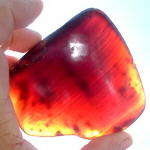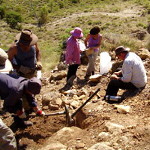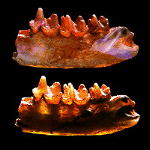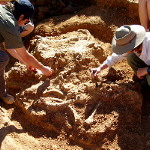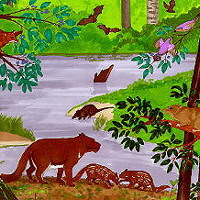 Tingamarra 50 million years ago. (Credit: Anne Musser). |
From Queensland to Peru: tiny marsupial spanned three continents15 January 2010 A newly discovered prehistoric marsupial has turned out to be almost identical to one otherwise only known from Peru - the first evidence that the same group of tiny land mammals spanned half the globe across the ancient supercontinent of Gondwana. The new kitten-sized marsupial, Chulpasia jimthorselli, had only minor differences from its Peruvian cousin Chulpasia mataueri, an international research team has reported in the journal GEOBIOS. The link is highly significant because it establishes that the same genus of marsupials spanned Australia, Antarctica and South America when the three continents were still joined as part of Gondwana during a warm "greenhouse" period about 55 million years ago. Its fossilised remains were found in the rich Tingamarra fossil site, near the Queensland town of Murgon. Fossils found there are from animals existing nearly 20 million years before Australia completely broke away from Antarctic, about 35 million years ago. They represent the only known window in time on what happened to Australia's mammals between the age of dinosaurs about 110 million years ago and the late Oligocene time, about 24 million years ago. "Clearly, the Tingamarra fauna is a critically important and unique window in time, the only one in an otherwise 86-million-year-long 'dark ages' for Australian mammals," says study co-author Professor Mike Archer, of the University of New South Wales, Sydney, who with other UNSW researchers worked with colleagues from the University of Lyon and Montpellier University. Chulpasia jimthorselli (named after Dr Jim Thorsell, a Canadian authority on World Heritage sites) would have resembled a modern-day Australian bandicoot, says Professor Archer. Its teeth suggest it was omnivorous - capable of eating a wide range of foods, including insects, fruits and even small lizards- and that it was probably reasonably common in its environment. The new fossils date back to a time when the Murgon region was covered in a cool but lush forest surrounding a lake inhabited by archaic but uniquely Australian crocodiles and giant soft-shelled turtles. Among the fauna in the surrounding forest and wetlands were primitive snakes, early Australian frogs, the world's earliest known songbirds, one of the world's earliest and most primitive bats and several as yet undescribed tiny mammals very similar to extinct South American mammals. As well as a placental mammal that became extinct, the site also featured Djarthia - the most primitive Australian marsupial known. Earlier research suggests that it later spread across Antarctica to become the ancestor of a mouse-sized marsupial known as Monito del Monte ("little monkey of the mountains") that lives on today only in southern Patagonia and Chile. Source: Riversleigh Notes |
Latest news
|




